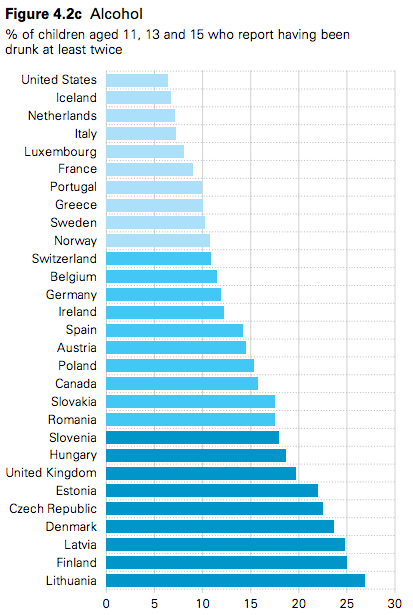
Actually, the results are only surprising if you’re a neo-prohibitionist or you’ve gotten all your information from them about underage drinking in the form of their relentless propaganda, posturing and fund-raising scare tactics. What a new study by UNICEF found was that the U.S. has the least number, or percentage, of kids drinking underage compared with nearly thirty developed countries. They looked at the drinking patterns of people 11, 13 and 15 years of age.
The study, Child Well-Being in Rich Countries, showed that overall the U.S. is in the bottom third, coming in number 26 of 29. Sad, really, but not terribly surprising if you’ve been paying attention. They looked at a variety of factors, and in Dimension 4 they tackled “risk behaviors,” including alcohol. Here’s how the 29 countries stacked up.

Other findings that contradict the standard anti-alcohol agenda and how they tend to frame the state of underage drinking include the following.
- More than three-quarters of the 21 countries also saw declines in alcohol use by young people – as measured by the proportion of 11-, 13- and 15-year olds who report having been drunk on at least two occasions.
- The biggest falls were again recorded in Germany (where the alcohol abuse rate fell from 18% to under 12%) and in the United Kingdom (which saw a decline from 30% to just under 20%).
The Washington Post reported these findings, but curiously spun the story as sort of a win for the neo-prohibitionists. The author, Max Fisher, suggests that because the U.S. is the country least likely to have kids drinking it “lends a bit of credence to the U.S.’s relatively late and well-enforced drinking age, unusual in the Western world.” Of course, there’s no causal link for such a statement whatsoever, but such is the power of decades of propaganda. As the Post’s foreign affairs blogger, he should probably stick to what he knows. He continues, saying that the U.S. is “joined by the tee-totaling kids of Iceland, the Netherlands and, believe it or not, Italy.” Iceland’s minium age is 20 (although “possession or consumption of alcohol by minors is not an offense”), the Netherlands is 16 (for alcohol that’s under 15% a.b.v., 18 if over) and Italy is 16. So there’s no real pattern that can be gleaned from the countries with the lowest reported underage drinking. And in fact the rest of the top ten are either 16, 18 or even have no minimum age, so trying to link a higher minimum drinking age with lower consumption is misleading at best, a little obnoxiously anti-alcohol at worst.
In the next paragraph he then contradicts himself. “Despite the strong wine cultures in Italy, France and Spain – or maybe because of them, given the degree to which it cultivates drinking “to enjoy,” as I’ve heard many French say – children in those countries are among the least likely to get drunk.” So in those “drinking cultures,” the kids aren’t as likely to get drunk for cultural reasons, but in our drinking culture it’s due to more stringent laws? With that attitude, no wonder he was surprised by the results of UNICEF’s study.
But in two of the countries with the most vocal anti-alcohol organizations, Great Britain and the U.S., not only are both countries lower than the propaganda might suggest, both nations have falling rates of this measure, too. In the U.S., we dropped from 12% to 6%, half of what it was just eight years before, And in the UK, it dropped from 30% to below 20%, falling more than a third. But as we’re learning, for many anti-alcohol organizations it’s not about results or the mission, it’s about punishment or profit for themselves. Even as rates of underage drinking continue to fall, their rhetoric increasingly gets turned up, becoming more radicalized and intransigent as they try to squeeze the last dollars out of their followers. It probably won’t surprise you to find out that not one of the usual neo-prohibitionist groups whose websites I checked even mentioned this study, despite it having been published over a week ago. If the results had been different, it would have been on their respective homepages immediately.


I haven’t check the study yet, but it will be interesting to see their collection method and reporting criteria. Social shaming often has more control over people than laws. A respondents willingness to admit to something will vary based on the level of social shame for whatever–even when confidential and no consequence. I would like to see a real scientific graph of how all these data interact. At best this probably is what researchers would consider a limited rough estimate for the potential and to not be taken definitively whatsoever. When comparing cultures, anthropologist generally know better than to try to compare different cultures in a quantitative and qualitative manner without fully investigating a purpose of each analysis, and how these results can and do interact. Statical analyses are only as good as the data used and how they are manipulated.